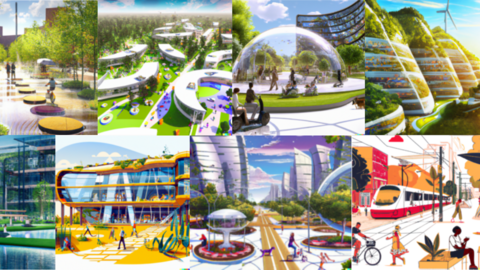
Using AI (DALL-E 2) to Visualize the Future in PLAN 211
By: School of Planning
This year, the PLAN 211: Design Studio Foundations course, taught by Dr. Katherine Perrott, partnered with the Sustainability Office to produce urban design visualizations that explore the possibilities of what the future of the University of Waterloo campus could look like when meeting the University’s sustainability goals. The students’ first project was to create a general idea of a sustainable campus by submitting prompts into the new cutting-edge technology: DALL-E 2.

From left to right: Valentina Casas, Paige Thompson, Kavishka Gomes, Tim Ross & Michael Barone.
DALL-E 2 is an artificial intelligence (AI) system that can design an entire image based on written prompts and was created by the same developer as ChatGPT: Open AI. It can recreate photos and art in a range of artistic styles, or design something never seen before. DALLE-2 opens many possibilities for creation and discovery. Being new, there is still much to discover about the platform and its potential. For design instructor Dr. Perrott, “it is important to show students how AI can be an appropriate tool for idea generation and exploration as long as students clearly acknowledge AI use as part of the broader creative process.” Her goal is to facilitate opportunities for students to critically engage with, and evaluate, new technologies like DALLE-2.
In this project, students were asked to start with an initial command for DALL-E 2 that captured components of a sustainable campus. They then continued to add commands and edits until the displayed image aligned with their vision. Students created posters with their images and a brief discussion about the strengths and limitations of the platform. The students took a stance on the question: “Is AI the future of Urban Design?” Students identified the limits of an algorithm for replicating the contextual knowledge, critical perspective, attention to diversity, and nuanced iteration of a human designer, but they recognized the power of AI to quickly turn ideas into images. These technologies are becoming increasingly powerful and accessible and as one student, Myah Sachedina, concluded: it’s not a question of if AI will be the future of urban design, but rather: “What will the future of urban design look like with AI?”
The final product is a studio gallery wall showcasing unique visualizations of what a sustainable future campus could look like, each one designed by a PLAN 211 student using DALL-E 2. The posters highlight biophilic design with nature, enhanced paths for walking and cycling, transit, water features, vibrant public spaces, and outdoor learning spaces. Each poster provides insight into sustainability, future campus design, and the use of AI in this context. Future assignments in PLAN 211 will generate ideas more specifically focused on the University of Waterloo and what our campus could look like in a sustainable future.
Be sure to visit the studio gallery, located in the corridor beside the Design Studio (EV3 2402) on the second floor of EV3, over the next 2 weeks.
Update: CBC interviewed Dr. Katherine Perrot, and PLAN 211 students Khalil Heron and Myah Sachedina about this project. You can find the written interview on the CBC News website and the radio interview on the CBC Listen website.